Despite being known as the “Land of 10,000 Lakes”, Minnesota has far more to offer than just aquatic animals. This beautiful state also has breathtaking mountains, prairies, and forests. Snakes are just one of many animals that live in these diverse ecosystems and there are seventeen different species of snakes in the state, including two that are venomous. Therefore, if you are spending time outdoors you probably want to know how to identify them. So join us as we identify some of the black snakes in Minnesota and discover which ones are dangerous!
1. Eastern Massasauga (Sistrurus catenatus)
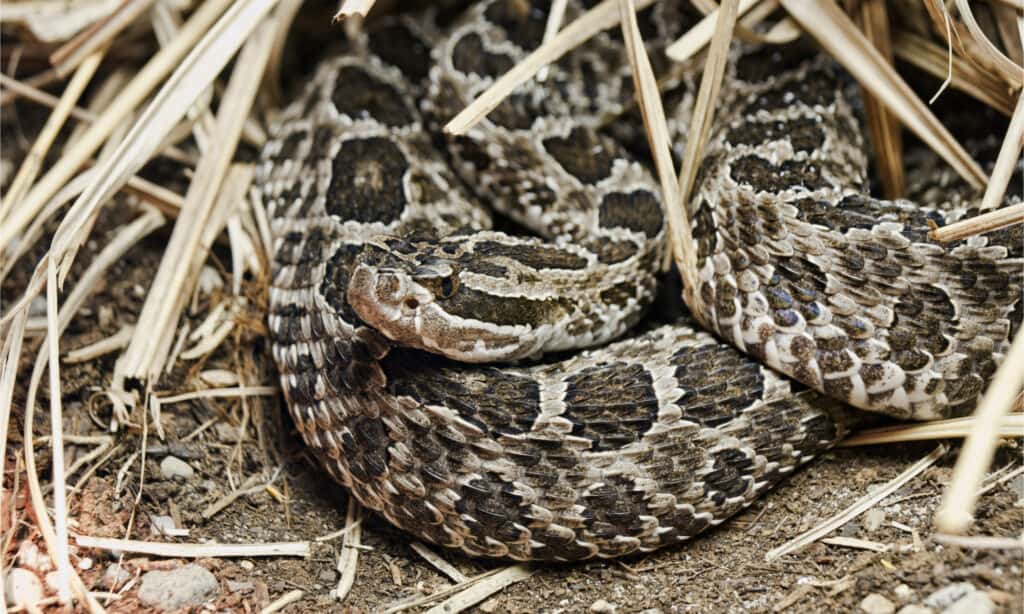
Eastern massasaugas are endangered species in Minnesota.
©DnDavis/Shutterstock.com
The first snake on the list is one of the two venomous snakes in the state – the eastern massasauga. Eastern massasaugas were formerly classified as a subspecies of the massasauga rattlesnake before being reclassified as a species of their own in 2011. They are typically 18 to 30 inches long and are greyish-brown with black blotches down the center of their back and smaller ones down their sides. However, some snakes can be almost completely black. Eastern massasaugas are an endangered species in Minnesota as sightings of them are so rare. They mainly live in habitats such as swamps, pastures, and woodlands but are restricted to only the southeastern region of the state, and even then their status remains questionable.
2. Ring-Necked Snake (Diadophis punctatus)
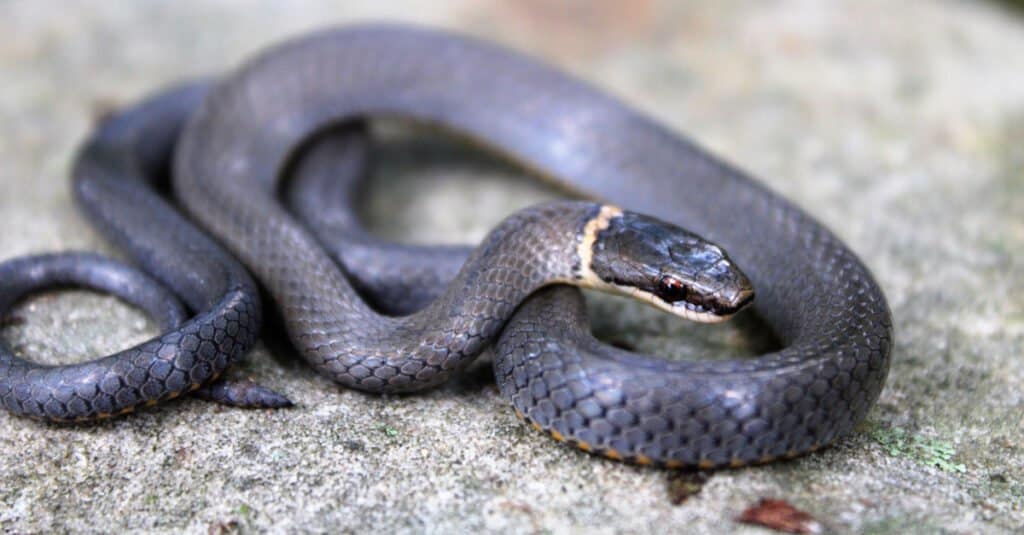
Ring-necked snakes are nocturnal and secretive.
©Tucker Heptinstall/Shutterstock.com
One of the smallest snakes in the state is the ring-necked snake which is only 10 to 20 inches long. Despite their small size, ring-necked snakes have a very distinctive appearance. They are usually dark grey or black with a brightly-colored neck ring. Sometimes their belly is the same color as their neck – either red, orange, or yellow. However, these snakes are often nocturnal, very shy, and secretive which means you are unlikely to spot one. They occur in eastern Minnesota near the St Croix and Mississippi rivers, mainly in forests. Ring-necked snakes produce a venom-like substance from the Durvenoy gland, but they are only mildly venomous to their prey and are not considered to be dangerous to humans.
3. Timber Rattlesnake (Crotalus horridus)
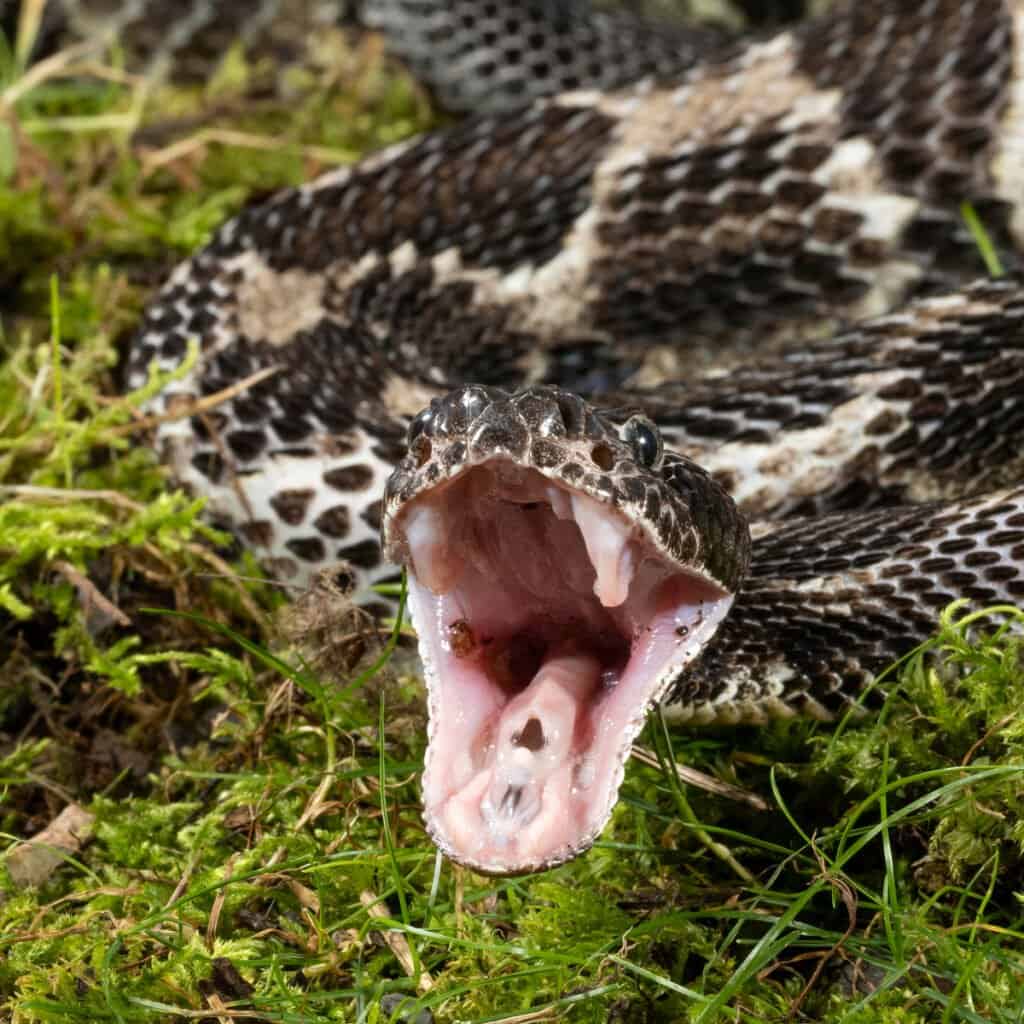
Timber rattlesnakes are venomous.
©Joe McDonald/Shutterstock.com
Another black snake in Minnesota and the second venomous snake is the timber rattlesnake. Timber rattlesnakes are large snakes with thick bodies that reach around 60 inches long. Although their most common color pattern involves a brown body with dark brown or black crossbands, they can be found with a “black phase” appearance. The black phase color morph is where they have a dark – almost black – ground color with darker indistinct markings. Although they are venomous, timber rattlesnakes are not particularly aggressive and don’t readily attack without reason. They are a threatened species in Minnesota and are only found in the southeastern region of the state where their habitats consist of blufflands, forests, and rocky outcrops.
4. Northern Water Snake (Nerodia sipedon)
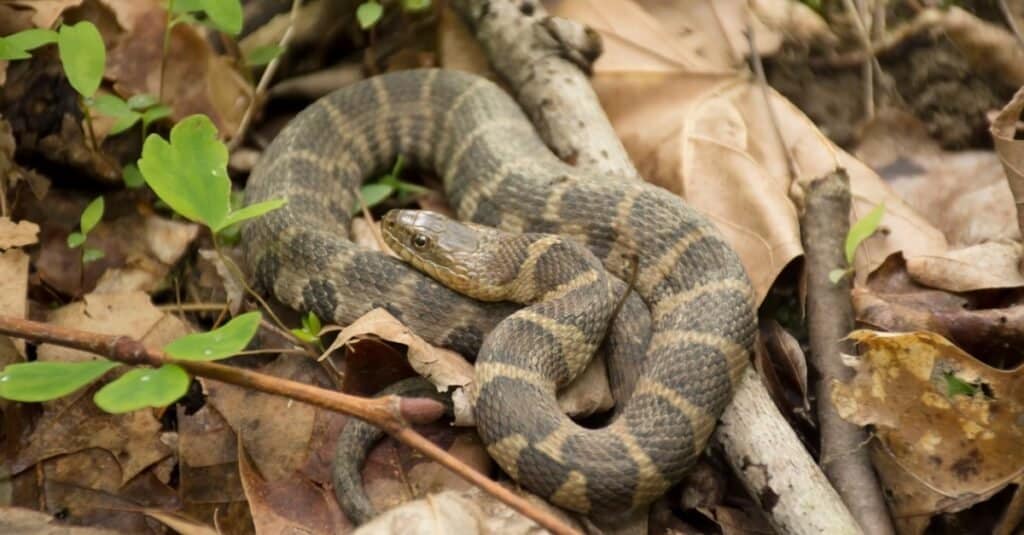
The northern water snake has a flat head that is as wide as its neck.
©iStock.com/IcemanJ
The only water snake in Minnesota is the northern water snake which occurs in most wetland habitats across the state but is particularly abundant along the Mississippi and St Croix rivers. Northern water snakes are 24 to 42 inches long and are dark grey or brownish-black with a series of darker crossband markings. They also have strongly keeled dorsal scales. Although northern water snakes are not venomous, they are aggressive and do readily bite if they are threatened or handled. Their saliva contains an anti-coagulant that prevents blood from clotting. This means that any wounds that they inflict will bleed a lot.
5. Western Rat Snake (Pantherophis obsoletus)
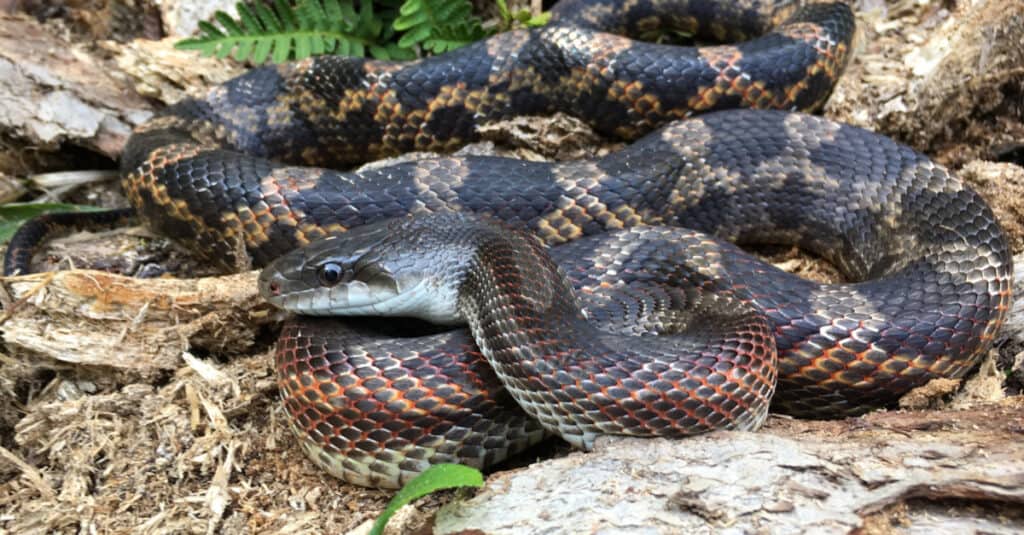
Western rat snakes come in many colors but darken with age and lose some of their patterns.
©Joe Farah/Shutterstock.com
Another black snake in Minnesota is the western rat snake which is also known as the black rat snake. Western rat snakes are 42 to 72 inches long and are typically black with white markings only on their lips, throat, and chin. However, juveniles look completely different and are grey with brown blotches. Western rat snakes darken with age, but sometimes it is possible to see just the outline of their juvenile markings. As their name suggests, they often prey on rodents which they kill by constriction. Western rat snakes are a threatened species in Minnesota. They live mainly in woodlands and on rocky bluffs in the southeast of the state – particularly on the Blufflands and the Rochester Plateau.
6. Common Garter Snake (Thamnophis sirtalis)

Common garter snakes are found near water sources in Minnesota.
©iStock.com/Wildnerdpix
The most widespread snake in Minnesota is the common garter snake which can be found right across the state. It is diurnal which means it is active during the day. Although it can live in a variety of habitats, it often lives in forests or grasslands near a permanent water source – such as a river. Common garter snakes are 18 to 36 inches long. They have green, brown, or black bodies with yellow or cream stripes down their back and sides. Common garter snakes are generally considered to be beneficial animals as they prey on pest species such as rats and mice. Interestingly, they also prey on toads but are immune to the poison secreted by them.
7. Eastern Hognose (Heterodon platirhinos)
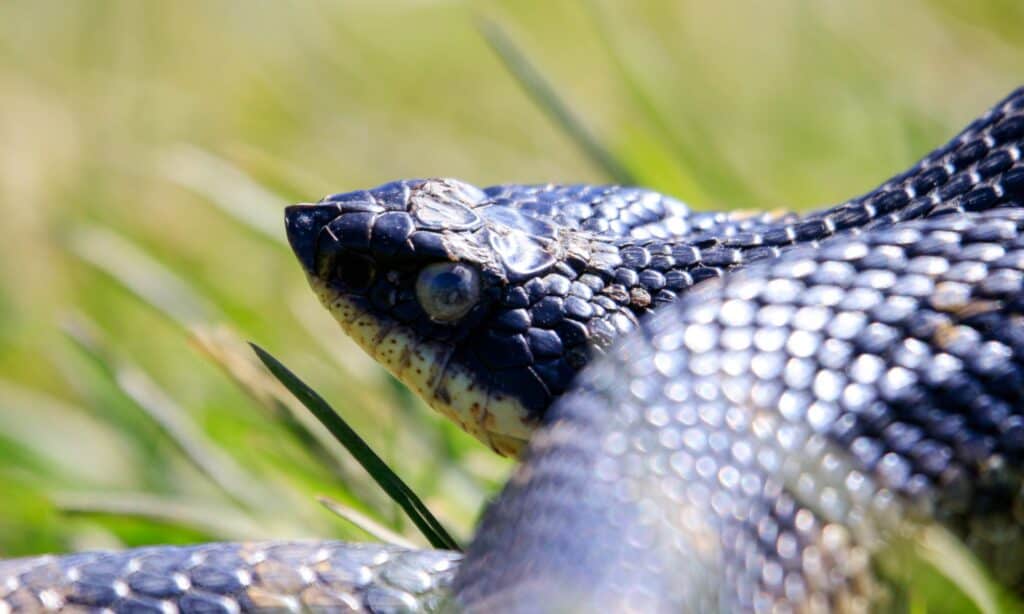
Eastern hognose snakes are known for playing dead to scare predators.
©iStock.com/mynewturtle
Also known as the spreading adder, the eastern hognose gets its nickname from the way it behaves when threatened as it flattens its neck out while hissing loudly. However, if that doesn’t deter their predator then it will take drastic action and play dead! Eastern hognoses are approximately 28 inches long and can be brown, black, grey, or red with dark brown or black blotches on their body. The most significant feature of the eastern hognose snake is its upturned snout used for digging in sandy soil. Eastern hognose snakes live in the eastern third of Minnesota where they can be found in forest edges and woodlands.
8. Bullsnake (Pituophis catenifer sayi)

Bullsnakes are nonvenomous.
©iStock.com/92968526
The final black snake in Minnesota is also the longest snake in the state. Bullsnakes are a subspecies of the gopher snake and can reach around 74 inches long. They have a yellow ground color which is covered with dark brown or black blotches. Bullsnakes usually typically live in prairies and pastures but in Minnesota, their range remains near the Mississippi, St Croix, and Minnesota rivers. Despite their large size, bullsnakes are not venomous, although they can mimic rattlesnakes when they are threatened. Their defensive behavior includes raising their head and neck above the ground while vibrating their tail in the leaf litter.
Up Next
- 17 Snakes Found in Minnesota (2 are Venomous)
- Discover the 2 Types of Rattlesnakes in Minnesota
- Discover the Deadliest Animals in Minnesota
The photo featured at the top of this post is © Joe McDonald/Shutterstock.com
Discover the "Monster" Snake 5X Bigger than an Anaconda
Every day A-Z Animals sends out some of the most incredible facts in the world from our free newsletter. Want to discover the 10 most beautiful snakes in the world, a "snake island" where you're never more than 3 feet from danger, or a "monster" snake 5X larger than an anaconda? Then sign up right now and you'll start receiving our daily newsletter absolutely free.
Sources
- Minnesota Department of Natural Resources, Available here: https://www.dnr.state.mn.us/rsg/profile.html?action=elementDetail&selectedElement=ARADB13030
- Minnesota Department of Natural Resources, Available here: https://www.dnr.state.mn.us/reptiles_amphibians/ringnecksnake.html
- Minnesota Department of Natural Resources, Available here: https://www.dnr.state.mn.us/rsg/profile.html?action=elementDetail&selectedElement=ARADB26020
- Minnesota Department of Natural Resources, Available here: https://www.dnr.state.mn.us/rsg/profile.html?action=elementDetail&selectedElement=ARADE03010#:~:text=The%20eastern%20massasauga%20(Sistrurus%20catenatus,whose%20collection%20location%20is%20questionable.
- Minnesota Department of Natural Resources, Available here: https://www.dnr.state.mn.us/eco/nongame/projects/timber_rattle.html
Thank you for reading! Have some feedback for us? Contact the AZ Animals editorial team.






